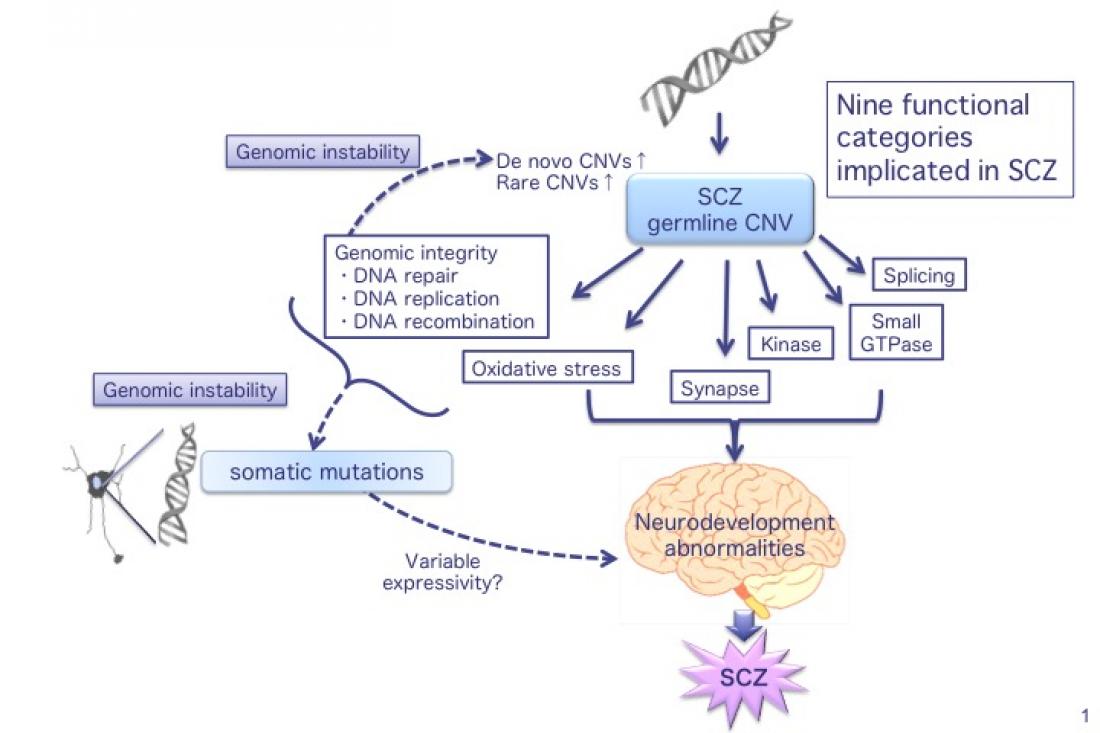A unifying genetic model constructed from the results of gene set analysis.
International researchers centered at Nagoya University use a highly sensitive technique to identify significantly more DNA sequence repeats in patients with schizophrenia than in control individuals, and outline a possible link between genome instability and disease.
Nagoya, Japan – Variations in the number of DNA sequence repeats are known to exist between individuals. Some of these copy number variations (CNVs) are associated with disease, as with schizophrenia, wherein rare CNVs on chromosomes, including 1, 15, 16, and 22, are more common among patients than among controls. However, previous studies have not fully investigated the effect of particular CNVs, especially those on the X chromosome, on patient characteristics. Nor have they examined the genes responsible for CNVs in schizophrenia, which would aid understanding of disease development.
An international research team centered at Nagoya University has now used a technique based on DNA fragments labeled with different fluorescent markers to reveal high levels of genetic heterogeneity (whereby several different genetic defects can cause the same symptoms) in schizophrenia. They also observed that the CNVs associated with schizophrenia affected gene categories controlling repair of DNA damage, which may underlie disease mechanisms. The study was reported in the Springer Nature journal Molecular Psychiatry.
The technique the researchers used was more sensitive and of a higher resolution than previous methods. This allowed detection of more CNVs, especially small ones, which accounted for 70% of all CNVs. Significantly more clinically important CNVs were seen in the DNA of 1,699 patients with schizophrenia than in the 824 control individuals, while abnormal numbers of X chromosomes were also associated with disease. High genetic heterogeneity was revealed by the detection of these CNVs at 67 different regions in 9% of patients. Further variation was observed in the effect of the CNVs on patient characteristics in that some CNVs were carried by controls without causing any symptoms.
“Patients with clinically important CNVs showed a range of characteristics, such as developmental problems and refusal to accept treatment,” first author Itaru Kushima says. “And, the presence of two CNVs resulted in a more severe phenotype.”
The researchers looked closely at the genetic regions containing CNVs to identify several gene categories associated with schizophrenia that may be affected by genetic disturbance. These include oxidative stress response, which leads to DNA damage when imbalanced, and genomic integrity, involving DNA repair and replication.
“We propose that CNVs affecting oxidative stress response and genomic integrity lead to genomic instability that may cause further CNVs”, corresponding author Norio Ozaki says. “This model helps explain the new CNVs seen in previous studies on schizophrenia, as well as the differences in affected patients’ phenotypes.”
[Image below: A unifying genetic model constructed from the results of gene set analysis. In SCZ pathogenesis, nine functional categories (oxidative stress response, genomic integrity, gene expression regulation, cell adhesion, neurotrophin signaling, kinase, synapse, small GTPase signaling, and endocytosis) are affected by germline CNVs. Disruption of genomic integrity and oxidative stress response induces genomic instability, which is involved in germline CNV formation and somatic CNV formation in neurons. The former accounts for an increased rate of de novo or rare CNVs, and the latter accounts for variable expressivity of CNVs.]



